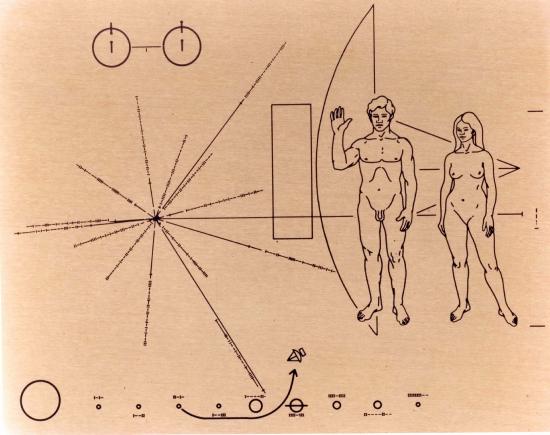15.4: The Fermi Paradox and the Search for Extraterrestrial Life
- Page ID
- 31182
15.4.1 Traveling to other worlds
The previous section discussed the possibility of communicating with extraterrestrial civilizations using conventional radio signals, but could we travel to other star systems and perhaps colonize other worlds. Science fiction stories often assume that some kind of faster than light (FTL) means of traveling will be discovered, enabling us to travel to other star systems in a matter of days. However, for the time being the speed of light remains the ultimate speed limit. We do not know of any means of traveling FTL. Using any of the means of propulsion known today, traveling to even the closest stars would take hundreds, if not thousands of years. This would require us to use multi-generation ships or find a way to cryogenically freeze humans and safely revive them once they arrive at their destination.
 Where are the aliens?
Where are the aliens?
https:/www.pickpik.com/alien-walking-on-pathway-ufo-guy-pozaziemianin-53615;
Consider the following thought experiment: An advanced civilization develops space travel technology that is just feasible enough to reach a nearby star. Traveling at less than 1/10th the speed of life, they could reach a star 5 light years away in about 500 years. Once at their new home, the people establish a colony, and within 500 years, they build two new ships and send them off to two different stars, each about 5 light years away from the colony. Each of those ships establish a colony, build two next ships, and send them off. Every thousand years, the number of new ships launched doubles, extending the reach of this interstellar civilization further away from their home world. How long would it take them to colonize every habitable planet in the galaxy?
This thought experiment assumes that there are habitable worlds separated by a mere five light years, but even taking into account only a 1 in 4 chance of there being a habitable world found after each 5 light year “hop,” mathematical models indicate that such a civilization will have extended its travels to a distance of 130,000 light years from its home world in about 50 million years.
The Milky Way Galaxy is about 100,000-120,000 light years across. This means, in 50 million years, our space faring civilization will have colonized the entire galaxy.
This may seem like a long time, but the Milky Way Galaxy is over 13 billion of years old, older than our own Solar System. Fifty million years is a small fraction of 13 billion. In all that time, there should have been at least one galaxy-colonizing civilization that has venture out and taken over the galaxy.
http://www.sentientdevelopments.com/2012/01/new-mathematical-study-reveals-that-our.html?m=1
So, where are they?
This lack of evidence of alien civilizations when mathematically, they should have already visited us, has been called the Fermi Paradox, after physicist Enrico Fermi. Even traveling at speeds slower than that speed of light and hopping from one star system to another every 1000 years, we would have expect an advanced alien civilization to reached our Solar System by now. On the other hand, even if the aliens did not travel to us, we should have detected their radio signals from any advanced alien civilization by now. After all, we have been sending our radio and television signals out into space for decades now. Why have we not picked out their signal? It could just be that the signals are too weak by the time they reach us that we cannot pick them up.
15.4.2 SETI
We have made a few attempts to reach out to alien civilizations. Both the Pioneer and Voyager probes carried a greeting with them. But it will be tens of thousands of years before any of them reach another star system, so we cannot expect a reply any time soon.
 The Pioneer probes both carried this plaque as a greeting to alien civlizations.
The Pioneer probes both carried this plaque as a greeting to alien civlizations.
https:/pixabay.com/photos/pioneer-badge-pioneer-10-space-probe-11055;
We are also communicating—although not deliberately—through radio waves emitted by broadcast stations. These have a 24-hour pattern, as the Earth rotates, bringing different broadcast areas rotate into view. Any alien civilization within a few tens of light years away may have the technology to pick them up.
However, we have not made many attempts to deliberately send a signal to any aliens who might be listening. In 1973, the Arecibo Radio Telescope in Puerto Rico was used to transmit an image in binary code that some scientists hope could be decoded by aliens. This message was beamed into the direction of the globular cluster M13 and included pixels encoding the following:
- The numbers one (1) to ten (10) (white)
- The atomic numbers of the elements hydrogen, carbon, nitrogen, oxygen, and phosphorus, which make up deoxyribonucleic acid (DNA) (purple)
- The formulas for the chemical compounds that make up the nucleotides of DNA (green)
- The estimated number of DNA nucleotides in the human genome, and a graphic of the double helix structure of DNA (white and blue, respectively)
- The dimension (physical height) of an average man (blue/white), a graphic figure of a human being (red), and the human population of Earth (white)
- A graphic of the Solar System, indicating which of the planets the message is coming from (yellow)
- A graphic of the Arecibo radio telescope and the dimension (the physical diameter) of the transmitting antenna dish (purple, white, and blue)
Since then, however, no other significant attempts have been made.
 This pixel message was sent out by the Arecibo Telescope as an attempt to greet alien civilizations in 1973.
This pixel message was sent out by the Arecibo Telescope as an attempt to greet alien civilizations in 1973.
If we were to deliberately broadcast signals that we wished to be found, what would be a good frequency? One suggestion has to be transmit in the “water hole” around the radio frequencies of hydrogen and the hydroxyl molecule. This corresponds to frequencies between 1.42 and 1.67 gigahertz. The background is minimal there, and it has been where we have been focusing many of our searches for alien signals.
SETI, the Search for Extraterrestrial Intelligence, is a privately funded effort to search for alien signals. These include the radio the telescopes of Project Phoenix, designed to search for extraterrestrial signals. Still, besides a few false alarms, we have not found anything that could be described as an artificial signal from an alien civilization.
So, why have we not heard anything? There are a few explanations for the Fermi Paradox. There is no definitive answer, so we will discuss a few them below.
Everybody is listening, but nobody is sending.
 https:/www.flickr.com/photos/cwkarl/9958455855;
https:/www.flickr.com/photos/cwkarl/9958455855; SETI is dedicated to listening for alien signals but is not actively sending out messages for extraterrestrials. Maybe the aliens are all doing the same. That might explain the absence of deliberate message but not any “leaked” messages from their own communications. Perhaps as we improve the sensitivity of our telescopes, such signals might be found.
The aliens have a non-interference rule.
 https://en.wikipedia.org/wiki/Times_Square
https://en.wikipedia.org/wiki/Times_SquareThis is a staple of science fiction, where advanced civilizations do contact less developed ones. In this scenario, aliens are observing us but are following a rule of non-interference so that they do not “damage” our culture. A related hypothesis is that they are treating us like zoo specimens. Could such a rule be enforced, especially if there are multiple, competing civilizations? What if a rogue actor decided to defy it?
We are looking in the wrong place.
 Could aliens be living inside a Dyson sphere?
Could aliens be living inside a Dyson sphere?
SETI has been focusing on frequencies in the “Water Hole” ~1.5 GHz where there is little background noise. What if the aliens are transmitting on a different set of frequencies? Or not sending out radio signals at all. Physicist Freeman Dyson suggested that a highly advanced civilization would need to capture virtually all of their sun’s output. To do this, they would need to surround their star with a construct or swarm of solar plants. If such a Dyson sphere, as they have come to be called, existed instead of looking for radio signals, perhaps we should be looking for waste heat in the form of infrared radiation instead.
Space is big.

In the previous section, we estimated that under a very optimistic set of assumptions, alien civilizations would be spaced an average of 100 light years away. We have only had radio technology for about a century, so if the aliens are more than 100 light years away, maybe their initial signals have not reached us yet. Such distances would also make it virtually impossible to ever visit them.
Advanced civilizations have a short lifespan.
 How long can a technological civilization last before it destroys itself?
How long can a technological civilization last before it destroys itself?
science-fiction-fantasy-weapons-ufo-warfare-female-warrior-future-mystery.jpg https:/www.pikist.com/free-photo-iptqh;
The truth is, we do not know how long technologically sophisticated civilizations last. If they have very short lives of few hundred years, they may be few and far between and never overlap.
Robots have replaced organic life.
 What if robots have replaced organic life?
What if robots have replaced organic life?
fantasy-alien-robot-futuristic-surreal-extraterrestrial.jpg https:/www.pxfuel.com/en/search?q=alien&page=5;
One reason technological civilizations might have short lives is because they were “replaced” by artificial intelligence. And now the robots see no reason to communicate with organic life.
They have retreated inwards.

This idea is that instead of looking outward to the stars, the aliens uploaded their consciousness into a computer simulation. In such a simulation, they could explore any kind of reality imaginable and have lost interest in the “real” universe. So, they are not interested in talking to us.
Intelligence is rare.
 How common is intelligence in the galaxy?
How common is intelligence in the galaxy?
the-thinker-rodin-paris-sculpture-preview.jpg https:/www.pickpik.com/search?q=thinking;
Life may be common, but intelligent life is rare. We tend to overvalue intelligence as it is our primary survival advantage, but the majority of species that have existed have gotten along fine without it.
Perhaps there are several filters, such as mass extinctions, that prevent intelligence from emerging. Considering the history of Earth and the numerous species that have gone extinct before homo sapiens evolved, perhaps we were just lucky to reach the level of intelligence we have. If we ever venture beyond our Solar System, perhaps will we find that on most worlds, life never evolved beyond the single cell stage.
We are like ants to them
 We may be as far below the aliens as ants are to us.
We may be as far below the aliens as ants are to us.
https:/www.pickpik.com/wood-ants-hand-risk-disgust-ants-spooky-87431;
They are so advanced that we are beneath their notice. Communicating with us might be to them what trying to have a meaningful conversation with insects would be for us. They just operate on a level that is beyond our understanding and we have nothing to offer them.
There is a conspiracy to hide them.
 Are aliens already here and the government is hiding them?
Are aliens already here and the government is hiding them?
600px-Conspiracy_Theories_Fallacy_Icon.png
This another staple of science fiction: Aliens have already been detected but the government is covering it up for some reason. This is probably unlikely, however. Despite the beliefs of numerous conspiracy theorists, governments are actually pretty bad at keeping secrets. The more people involved in a conspiracy to cover up something big like alien contact, the more likely someone will speak out or accidentally let the information slip out.
We are alone.
 Are we alone in the galaxy?
Are we alone in the galaxy?
Finally, we may have to face the possibility that life is rare. So rare, that it has only happened once in our entire galaxy.

